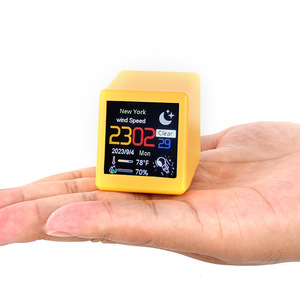
All categories
Featured selections
Trade Assurance
Buyer Central
Help Center
Get the app
Become a supplier

(525473 products available)




















































The types of animated cartoon clocks are various. They include different styles and animations of cartoons.
Cartoon character alarm clocks
These clocks have famous cartoon characters like Mickey Mouse or SpongeBob SquarePants. They may have static images or moving parts. For example, the arms of a character may move to show the time. Some clocks have alarms with the character's voice or theme music.
Cartoon animal clocks
These clocks feature animated animal designs. A clock may have a bird that tweets to display the time or a cat that shakes its tail. Some common animals are birds, cats, dogs, and rabbits. They may also have their sounds as alarm tones.
Customizable cartoon clocks
Some clocks let users customize them with their cartoons. Users can select from different cartoon faces and themes to fit their style. They can choose a character's expression and change the clock's appearance.
Educational cartoon clocks
These clocks help children learn to tell time. They have interactive features and animations. They explain time concepts through moving hands or animated characters. They may have games, quizzes, and rewards for learning to tell the time.
Classic cartoon clocks
These clocks have retro designs from old cartoons. They may have classic cartoon characters or styles from the 1920s to 1960s. For example, some clocks may have Betty Boop or Looney Tunes characters.
LED digital cartoon clocks
These clocks have cartoon designs with LED screens. They show the time in bright, colorful digits. Some designs also have animated effects or change the display.
Mechanical cartoon clocks
These clocks have cartoon designs with mechanical movements. They may have animated figures or scenes that move with the clock hands. Some common examples are dancing characters, moving animals, and changing faces.
Designing an animated cartoon clock involves a combination of creativity, technical skills, and an understanding of the principles of animation and timekeeping. Here are some key aspects to consider when designing such clocks:
Designing an animated cartoon clock is a fun and challenging process that requires a blend of art and science. By considering these aspects, one can create a clock that is not only a practical timekeeping device but also a delightful piece of animation that brings joy to its viewers.
Different situations and environments show the usefulness and appeal of these clocks in many ways. They improve learning, bring joy, and make places look nice in various ways.
When animated clocks are to be purchased, there are some things that need to be considered so that the right one is chosen. One must think about the functions of the clock and the surroundings in which it will be placed. Different animated clocks have different functions. Some clocks may only display time animation, while others may have alarms, timers, and ambient light settings. Choose a clock that fits the needs and preferences. Consider the clock's design and the decor style of the room it will be placed in. If the clock is for a child's room, pick a design and color that are attractive to children. But if it's for an office or living room, a sleek and professional look may be more suitable.
Also, make sure that the numbers on the clock can be seen clearly and that the animation is easy to understand at a distance. The size of the animated clock should fit the space where it will be placed. A large clock may overwhelm a small room, while a small clock may be hard to see in a large room. Some clocks have adjustable volume settings or silent modes, allowing users to customize the sound according to their preferences and the environment.If the clock runs out of batteries quickly, it may not be of good quality. Choose one with good battery life. If the clock has features like brightness adjustment, it can help prevent eye strain and improve visibility, especially in low-light conditions. Some high-quality animated cartoon clocks are designed to be durable and may come with warranties. Don't hesitate to invest a bit more for better quality and after-sales support.
Q1: Are the clocks durable?
A1: Yes, these clocks are made from good-quality materials. They can last a long time with proper care.
Q2: Do these clocks use batteries?
A2: Most animated clocks run on batteries, but some may need a plug to work. It is essential to check this detail before buying the clock.
Q3: Can the animations be turned off or changed?
A3: Yes, many clocks allow the animation to be turned off or changed. They let users customize what they want to see.
Q4: Are these clocks suitable for all age groups?
A4: Animated clocks appeal to many ages, but some designs may be better for younger people or specific tastes.
Q5: How do users set the time and animation?
A5: Setting the time on an animated cartoon clock is as simple as drawing an analogy to setting a regular alarm clock. They usually have buttons or knobs to adjust the time and start the animations.